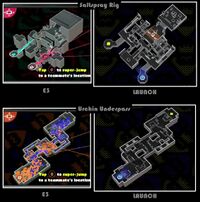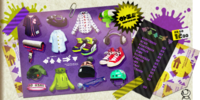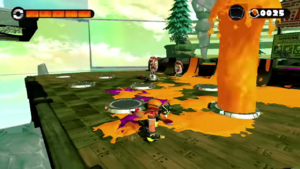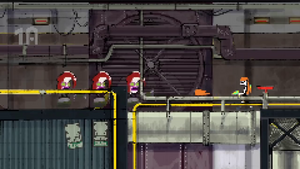Unused content in Splatoon
This page documents content included in pre-release versions of Splatoon that was not included in the released game and content that was found in the game's files that was not made available.
Multiplayer

Various changes in the multiplayer modes can be seen, including map differences and minor cosmetic differences.
- Signals were different. In the prerelease version, there was one signal with the text "Signal" rather than two signals.
- An unused color, known in the database as MothGreen, was to be used in Octo Valley and presumably multiplayer. It was shown in several trailers and images, and it is also seen on the back cover of the Splatoon disc case.
Weapons
- Footage showing the Dynamo Roller in the Octo Valley trailer showed that its roller head, and presumably all other rollers' heads, did not fold to the side while standing still or running in humanoid form.
- The Classic Squiffer initially had Burst Bombs as its sub weapon, according to the Octo Valley trailer.
- The Classic Squiffer had a different sticker attached to the tube of the weapon.
- Burst Bombs would have been able to instantly splat opponents within its radius.
- Early concept art and the Octo Valley trailer showed the Rapid Blaster had the bottom part of the Rapid Blaster Pro attached to it.
- A pre-release image of Blackbelly Skatepark and the Octo Valley trailer shows that the Inkbrush's bristles would have initially and always been curved inward, similar to how it appears when rolling.
- Another pre-release image and the E3 2014 announcement trailer show an Inkling using what is either an unused scoped charger or a Splatterscope with an unused skin.
- Early weapon icons found in Super Mario Maker's internal data show what Splatoon may have looked like during early development.[1] Many weapons were not finished, and simply reskins of the default weapon of each class, such as the Splattershot and Splat Roller. Notably, various icons seem to be for weapons and entire weapon classes that did not make it to the final game, such as the "Launcher" class icons. Also, a placeholder icon can be found for weapons that did not have an icon at the time. These weapons include:

Stages
- An early version of Arowana Mall was slightly thinner, had overhanging roofs and pillars along the side, and featured a thin gate towards what appears to be the center of the stage.
- Blackbelly Skatepark originally featured stairs near the ends of the stage and at the entrance to the central area surrounding the tower.[2]
- Saltspray Rig originally had small areas further to the left and right of the stage, and the bottom platform was split into two and could only be accessed from the sides.
- The center of Urchin Underpass was originally larger and had two central entryways from each side instead of one.
- Camp Triggerfish originally had fewer walls to defend players. The overall layout was much wider and open compared to when it was released.
Gear

Several pieces of gear could be found in the files, yet have never been made officially obtainable and were eventually removed in Version 2.3.0. These scrapped gear items were, however, fully functional if hacked into the game. Other items were simply reworked before the full release of the game and have the same attributes as legally-obtainable gear.
Sunken Scroll 18 is notable for showing off a scrapped item (the Shirtstravaganza) and an early design for the Stealth Goggles, as well gear with somewhat off colors.
Scrapped gear
- The Warrior Headdress was based on war bonnets worn by Native Americans of the Great Plains and Canadian Prairies. It has sprites found within Super Mario Maker and Splatoon's files. This piece of headgear was produced by Forge, and was most likely removed to avoid controversy.
- The Shirtstravaganza was a shirt bearing a strong resemblance to the Baby-Jelly Shirt. It has sprites found within Super Mario Maker and Splatoon's files. It is light blue with red buttons and features navy markings across its fabric. It was also produced by Splash Mob.
- The Shirtstravaganza was believed to be an early concept to the Baby-Jelly Shirt due to their extremely similar designs. However, both items coexist in early builds of Splatoon. Instead, the Shirtstravaganza shares an internal name with the Rodeo Shirt, suggesting it was remade from the ground up, possibly for being too similar to the Baby-Jelly Shirt.
- The SquidForce White was a variant of the White Layered LS with no long-sleeved tee underneath (similar to the White Tee versus the Camo Layered LS).
- The Varsity Hoodie was a hoodie similar to the Varsity Jacket. It has sprites found within Super Mario Maker and Splatoon's files. It is bluish gray with brown sleeves and was produced by Splash Mob.
- The Varsity Hoodie was previously believed to be an early concept for the Varsity Jacket. However, both items coexist in early builds of Splatoon. Just like the Shirtstravaganza and Baby-Jelly Shirt, though, they coexist in early builds of the game.
- The White Puffer Tee was a variant of the Fugu Tee.
- The Fugu Tee used to be called the Charcoal Puffer Tee to match its white counterpart. Interestingly, the NoA French release has kept the localized name ("T-shirt Arki charbon") despite the removal of the White Puffer Tee.
-
Warrior Headdress
-
Shirtstravaganza
-
SquidForce White
-
Varsity Hoodie
-
White Puffer Tee
Early designs
- The Stealth Goggles had a green icon with blue lenses. It has sprites found within Super Mario Maker and Splatoon's files.
- The Layered Anchor LS used to be dark gray instead of burgundy, and the sleeves had a bluish sheen.
- The shades of purple used on the Purple Camo LS were a little pinker. The orange armband used to be yellow, and its placement on the shirt was slightly lower. It has sprites found within Super Mario Maker and Splatoon's files.
- The Reel Sweat used to be light gray and was even originally referred to as the "Gray-Reel Sweat" (or "Grey Reel Sweat" in Europe).
- Strangely enough, the NoA French release has kept the localized name ("Coton ouaté cylindre gris", or Cylinder gray sweater) much like the Fugu Tee, even though the sweater has become as red as its logo.
- The Round-Collar Shirt used to be gray.
- An icon exists for the Armor Boot Replicas, which is nearly identical to the icon used in the final version. The most noticeable change is the slightly less shiny inside of the boots.
- The Custom Trail Boots had a blue palette with a green tongue, red shoelaces and burgundy socks. The colors of the soles were also switched around.
-
Early sprite for the Stealth Goggles.
-
Early sprite for the Layered Anchor LS.
-
Early sprite for the Purple Camo LS.
-
Early sprite for the Gray-Reel Sweat, now Reel Sweat.
-
Early sprite for the Round-Collar Shirt.
-
Early sprite for the Armor Boot Replicas.
-
Early sprite for the Custom Trail Boots.
Octo Valley


The 5 November 2014 Nintendo Direct showed off what would later be known as Octo Valley for the first time. However, there were many differences compared to the mode in the final release.
Entrance
The entrance to Octo Valley is Cap'n Cuttlefish's manhole. However, back then, the location of the manhole was slightly different. It was still in a corner, but there were no trash cans or a vending machine nearby. This might have been a different location, or perhaps the trash cans and vending machine were added later on.
Before the game's release, it showed a white wall behind Cap'n Cuttlefish's manhole, which means it could have been near Shrimp Kicks or probably somewhere close to Booyah Base. But this could also mean that Cap'n Cuttlefish was actually at the location where Spyke is in the final game. Another difference is that the lid of his manhole is not a grate, like in the final game, but a flat, solid, surface.
Health meter and Sunken Scrolls
In the prerelease version, the player had five lives; in the full game, this was reduced to three, presumably for a little more challenge. Also, the outline for the Sunken Scroll is different from the outline in the final version. Here, it looks more like an outline for two sheets of paper rather than an actual scroll.

Enemy differences and unused enemies
In one part of the single player trailer which appears to be in a level similar to the final game's Shifting Splatforms, a normal, standing Shielded Octotrooper can be seen firing ink rapidly. In the final game, this trait is only given to Twintacle Octotroopers, as normal Octotroopers only fire one blob of ink at a time.
An unused Octarian variant can also be seen in the video. It appeared to be quite tall, wearing what appears to be a cloak, and was supposed to appear in a pool of ink. It is unknown if this was an early Octosniper, or just a different cut enemy.

Stages
- Gusher Gauntlet had a different skydome, and the gushers seen in the trailer did not have spigots on them. Checkpoint 3 had the player fight normal Octotroopers instead of Twintacle Octotroopers, a far fence and floating rock were missing, and the platform the Octotroopers spawn from was originally lower and was colored less vibrantly.
Inkopolis Plaza
As shown in some screenshots, Inkopolis Plaza had a slight redesign before the game was released. All of the changes were aesthetic and did not affect the Plaza.
- The alley where Spyke resides in the final game was originally where the porthole to Octo Valley was. In the final game, the porthole was moved to the right side of the Inkopolis Tower near the vending machines.
- The Squid Sisters' studio did not have a background and had the sisters stand near the television instead of sitting on the two seats in the final game.
- There was originally a tree next to Cooler Heads that was removed in the final game.
- A lamp pole near Spyke's alley was removed in the final game, as well.
- The yellow concrete arrow near Inkopolis Tower originally pointed upwards and was shaped like a squid.
Other

- As with many games, the light engine was much darker in the pre-release version.
- There is footage of some sort of 2D retro-style gameplay showing an Inkling shooting at an Octotrooper. Nothing like this appeared in the final game, but it may have been intended as part of the arcade machine.
